Chesapeake Bay Retrievers Dog
- February 1, 2024
- 0 comment
The Chesapeake Bay Retriever, often affectionately known as the “Chessie,” is a remarkable breed known for its exceptional retrieving abilities and unwavering loyalty. Originating from the Chesapeake Bay area of Maryland in the early 19th century, these dogs were selectively bred to become expert waterfowl hunters. They possess a sturdy and muscular build, with a distinctive double coat that provides insulation and protection in harsh weather conditions, especially during water retrievals. Chessies are characterized by their webbed toes, aiding them in swimming with ease.

But what truly sets them apart is their remarkable temperament. Chesapeake Bay Retrievers are renowned for their loyalty and strong bonds with their families. They are intelligent, eager to please, and quick learners, making them a joy to train. Their fearlessness and tenacity are notable when it comes to retrieving games from challenging aquatic environments.
Not limited to hunting, these versatile dogs also excel in search and rescue operations and various dog sports, showcasing their agility and athleticism. While their exercise needs are substantial, they reward their owners with unwavering devotion and companionship. With their unique appearance, incredible work ethic, and loving disposition, Chesapeake Bay Retrievers continue to capture the hearts of dog enthusiasts worldwide, making them more than just pets but cherished members of the family.
| Characteristic | Description |
|---|---|
| Size | Medium to large |
| Height (Male) | 23 to 26 inches at the shoulder |
| Height (Female) | Slightly smaller than males |
| Weight (Male) | 65 to 80 pounds |
| Weight (Female) | Slightly lighter than males |
| Coat Type | Double coat with dense, waterproof outer coat |
| Coat Colors | Brown, sedge, and deadgrass |
| Coat Texture | Often wavy |
| Webbed Toes | Yes, aiding in swimming efficiency |
| Temperament | Loyal, protective, intelligent, eager to please |
| Lifespan | 10 to 12 years on average |
| Exercise Needs | High energy level, regular exercise required |
| Grooming Requirements | Regular brushing, minimal bathing |
| Trainability | Quick learners, enjoy mental stimulation |
| Specialized Skills | Waterfowl hunting, search and rescue, dog sports |
| Compatibility with Other Pets | Possible with socialization and training |
The Mighty Chesapeake Bay Retrievers: A Breed with a Story

When it comes to loyal companions with a love for water and an unmatched work ethic, Chesapeake Bay Retrievers (CBRs) stand out among the canine community. These remarkable dogs have a rich history, unique characteristics, and a strong bond with their human counterparts. In this article, we’ll dive into the world of Chesapeake Bay Retrievers, exploring their origins, physical traits, temperament, and more. So, grab your life jacket, and let’s embark on a journey to discover these incredible four-legged friends.
The Origins of Chesapeake Bay Retrievers
Chesapeake Bay Retrievers, also known as CBRs or Chessies, trace their ancestry back to the early 19th century in the Chesapeake Bay area of Maryland, USA. Originally bred for their outstanding retrieving skills, they are a product of crossing various breeds, including Newfoundlands, Bloodhounds, and Irish Water Spaniels. These unique combinations gave birth to a breed renowned for its waterfowl hunting abilities and resilience in harsh weather conditions.

Physical Characteristics

A Sturdy Build
One glance at a Chesapeake Bay Retriever, and you’ll notice their strong, muscular physique. They are medium to large-sized dogs, with males typically standing 23 to 26 inches tall at the shoulder and females slightly smaller. Their rugged build and deep chest allow them to excel in strenuous activities, especially in the water.
Distinctive Coat
CBRs have a double coat that serves as their natural armor against cold waters. The outer coat is dense, harsh, and waterproof, while the inner coat provides insulation. Their coat colors can vary, including shades of brown, sedge, and deadgrass, often with a distinctive wavy texture.
Webbed Toes
One of the unique features of Chesapeake Bay Retrievers is their webbed toes. This adaptation aids them in swimming efficiently, making them masters of retrieving waterfowl from challenging aquatic environments.

Temperament and Personality
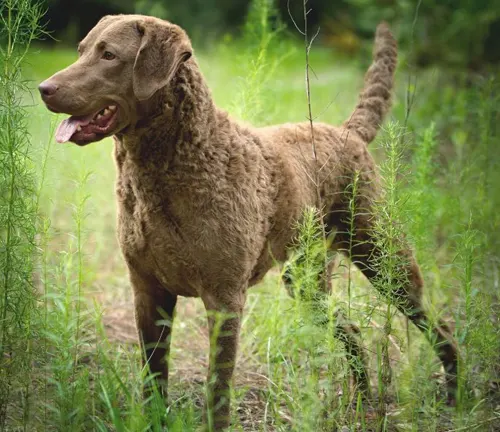

Loyalty Beyond Measure
Chesapeake Bay Retrievers are renowned for their unwavering loyalty and dedication to their owners. They form strong bonds with their families and are known to be protective, making them excellent watchdogs.
Intelligent and Eager to Please
Their intelligence is off the charts, making them a joy to train. Chessies thrive on mental stimulation and love to learn new commands and tasks. They are eager to please their owners, which makes training sessions enjoyable for both parties.
Fearless and Tenacious
When it comes to retrieving game from water, Chesapeake Bay Retrievers are fearless and tenacious. Their determination to accomplish tasks in challenging conditions is a testament to their hunting heritage.
The Chesapeake Bay Retriever as a Working Dog
Waterfowl Retrieval
CBRs excel in retrieving waterfowl, thanks to their exceptional swimming skills and strong jaws that allow them to carry heavy game.
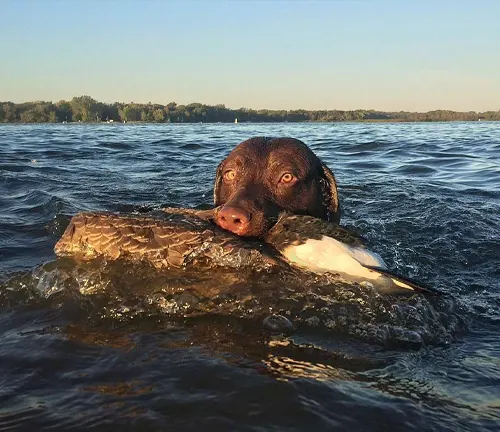
Search and Rescue
Their sharp instincts and strong sense of smell have also made Chesapeake Bay Retrievers valuable in search and rescue operations. Their ability to locate missing persons in water or on land has saved many lives.

Competitive Dog Sports
These versatile dogs participate in various dog sports like agility, obedience, and dock diving, showcasing their athleticism and versatility beyond their hunting abilities.
Health and Care
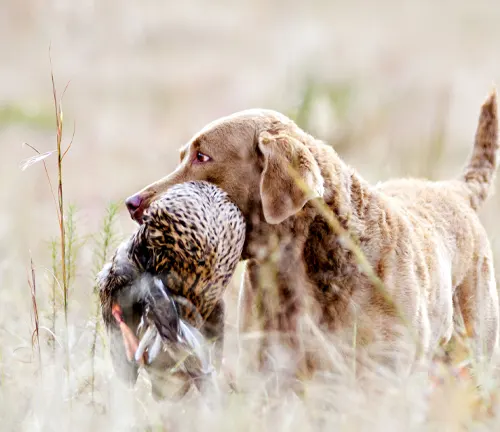
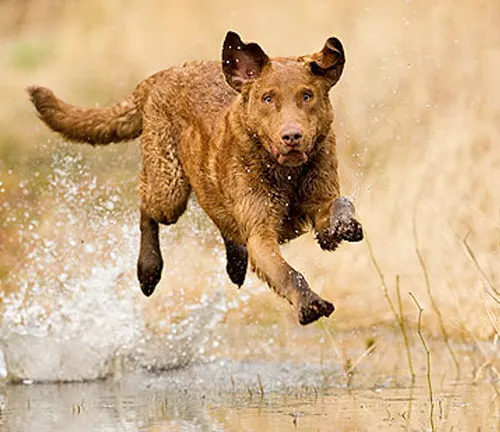

Regular Exercise
Chesapeake Bay Retrievers are highly energetic dogs that require daily exercise to stay fit and content. Engage them in activities like swimming, fetching, and brisk walks to fulfill their physical needs. Mental stimulation through puzzle toys and obedience training is also crucial to keep their sharp minds active.
Proper Nutrition
Feed your Chesapeake Bay Retriever a balanced diet appropriate for their age, size, and activity level. High-quality dog food that meets their nutritional needs is essential. Consult with your veterinarian to determine the right portion sizes and feeding schedule.
Grooming
Chessies have a dense, waterproof double coat that requires regular grooming. Brush their coat at least once a week to remove loose fur and prevent matting. Bathing should be infrequent to preserve the natural oils that protect their coat.
Health Checkups
Regular veterinary checkups are crucial to monitor your dog’s overall health. Vaccinations, parasite control, and dental care are all aspects that your veterinarian will address. Be sure to discuss any concerns or changes in behavior with your vet promptly.
Socialization and Training
Early socialization is essential to help your Chesapeake Bay Retriever develop into a well-adjusted and friendly adult dog. Expose them to various people, animals, and environments to build their confidence and reduce any potential behavioral issues. Training should be positive, consistent, and based on positive reinforcement techniques.
Hydration
Chessies have a love for water, but they can also overheat easily. Ensure they have access to fresh water at all times, especially during outdoor activities. Watch for signs of overheating, such as excessive panting, and provide shade and breaks as needed.
Exercise Caution in Cold Water
While Chessies are known for their love of water, exercise caution when they swim in cold conditions. Their double coat provides insulation, but they can still be vulnerable to hypothermia in very cold water.
Maintain a Safe Environment
Make your home safe for your Chessie by keeping hazardous chemicals, foods, and small objects out of their reach. Chessies are known for their curiosity, so puppy-proofing your living space is essential.
Emotional Well-being
Chesapeake Bay Retrievers are loyal dogs that thrive on human interaction. Spend quality time with them, provide plenty of love and attention, and consider crate training to provide them with a safe space when needed.
Regular Exercise
Chesapeake Bay Retrievers are highly energetic dogs that require daily exercise to stay fit and content. Engage them in activities like swimming, fetching, and brisk walks to fulfill their physical needs. Mental stimulation through puzzle toys and obedience training is also crucial to keep their sharp minds active.
Different Species
Brown
Brown is the most common color for Chesapeake Bay Retrievers. It can vary from a light tan or chocolate brown to a deep, dark brown.

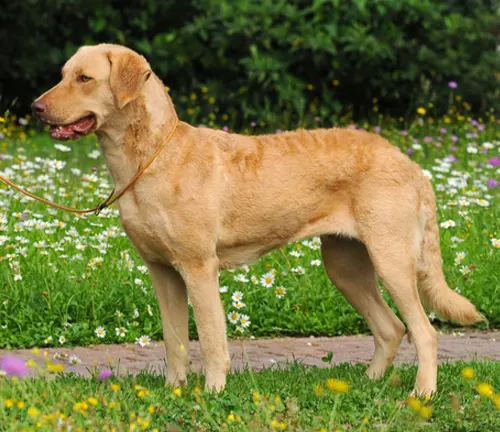
Sedge
Sedge is a reddish-brown or reddish-gold coloration, often with a lighter or yellowish tint.
Deadgrass
Deadgrass refers to a lighter shade, often pale tan or straw-like in color.
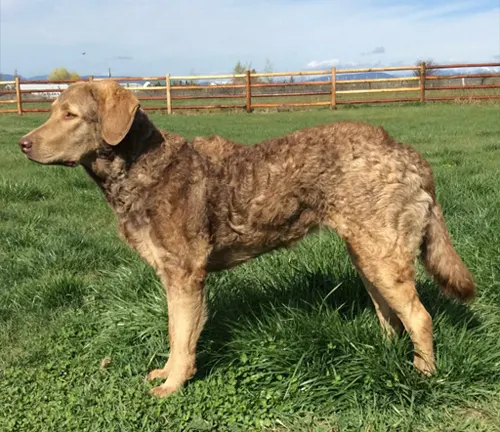
Frequently Asked Question (FAQs)
- What is a Chesapeake Bay Retriever?
A Chesapeake Bay Retriever, or CBR, is a breed of dog known for its strong retrieving abilities, particularly in waterfowl hunting. They are medium to large-sized dogs with a distinctive double coat. - Where did Chesapeake Bay Retrievers originate?
Chesapeake Bay Retrievers originated in the Chesapeake Bay area of Maryland, USA, in the early 19th century. They were bred for their hunting and retrieving skills.” - What are the typical physical characteristics of a Chesapeake Bay Retriever?
CBRs have a strong, muscular build with a dense, waterproof double coat. They often have webbed toes to aid in swimming. Coat colors can vary but include brown, sedge, and deadgrass. - Are Chesapeake Bay Retrievers good family pets?
Yes, they can be excellent family pets. They are loyal, protective, and often great with children when properly socialized and trained. - Do Chesapeake Bay Retrievers require a lot of exercise?
Yes, they are an energetic breed that needs regular exercise to stay healthy and happy. Activities like swimming, walks, and interactive playtime are essential. - How long do Chesapeake Bay Retrievers live?
On average, Chesapeake Bay Retrievers have a lifespan of 10 to 12 years, but this can vary based on individual health and care. - Do they shed a lot?
They do shed, but regular grooming can help manage their shedding. Their double coat sheds seasonally. - Can Chesapeake Bay Retrievers get along with other pets?
With proper socialization, they can coexist peacefully with other animals, but early training and supervision are important. - Are they good at hunting and retrieving game?
Yes, Chesapeake Bay Retrievers excel at hunting and retrieving waterfowl, making them popular choices among hunters. - Where can I find a Chesapeake Bay Retriever puppy or adopt one?
You can find CBR puppies from reputable breeders who prioritize the health and well-being of their dogs. Alternatively, consider adopting from rescue organizations dedicated to the breed.



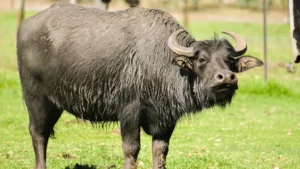





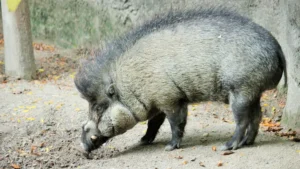




Leave your comment